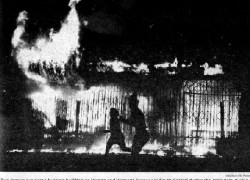
Twenty years ago today, stricken with uncertainty about reports of rioting and looting in Los Angeles, a crowd of UCLA students, faculty and staff gathered in Bruin Plaza.
Rioting erupted throughout the city on April 29, 1992, after verdicts were released in a case regarding four Los Angeles police officers who had been videotaped beating black motorist Rodney King. The tape surfaced on a local television station in 1991.
The beating incident had become notorious. But large-scale rioting broke out after the verdicts were announced, acquitting the officers involved.
Businesses and homes were set on fire or looted by rioters in the chaos that followed. High economic disparity, high unemployment, police abuse and tense race relations have been cited as factors contributing to the severity of the riots.
Sunday marked the twentieth anniversary of the start of the L.A. riots, the effects of which reverberated on the UCLA campus.
An uneasy atmosphere
For three to four days following the release of the verdicts, most of UCLA and Westwood were shut down and blocked off from the rest of Los Angeles, said Bryant Delgadillo, a UCLA alumnus.
“I remember there were cops and the National Guard everywhere, and the entries into Westwood were cut off, so no one could really get in or out,” he said, describing the campus as a “ghost town.”
Another UCLA alumna, Asani Charles, remembered returning to school the day after the verdicts were released following a night with her family in Crenshaw. She found a massive crowd assembled in Bruin Plaza.
She tried to make her way to class until her professor grabbed her and told her to sit down and listen.
At about 11:45 a.m. on April 30, 1992, loudspeakers across campus informed students and faculty that the UCLA campus would be closing at noon that day. They would be expected to be off the campus at that time.
“That’s when I really started to be afraid,” Charles said.
The scent of smoke from fires, set across Los Angeles during the riots, stands out most in the memory of Dominiqua Dickey, a resident assistant in Hedrick Hall at the time.
Dickey felt protected in Westwood. But she has not forgotten that smell, 20 years later, she said.
Teaching at UCLA at the time, Joel Aberbach, a professor of political science, said he experienced the events solely through television coverage. He said he remembered being shocked by the verdicts more than the rioting itself.
While there were a few isolated incidents of store vandalism in Westwood at the time, UCLA was mostly affected by the tense atmosphere the events created after the fact than by the actual riots, said Daniel Mitchell, a professor emeritus of UCLA Luskin School of Public Affairs and the UCLA Anderson School of Management.
Reflections by a researcher
Darnell Hunt was a graduate student at the time of the riots, studying race and media.
“I was looking for a case study,” he said. “And then the riots happened.”
He immediately focused on the reaction to the news coverage of the riots, which would later form the basis for his dissertation. Hunt took his camcorder down to the center of the protests and left the VCR running, he said, so he could compare the media’s take on the events that day compared to the reality just outside as part of his research.
Hunt is now a sociology professor at UCLA, and director of the Ralph J. Bunche Center for African American Studies. While he witnessed firsthand much of the upheaval across the city while conducting his research, he said he found optimism in the clean-up period following the six days that the riots took place.
“People saw (the aftermath) as this moment when people came together around a common cause, across racial lines, and talked about the possibility of coalitions and achieving some type of progress,” he said.
Hunt’s research from 20 years ago, which he continues to observe and build upon, showed that people of different ethnicities perceived media depictions differently.
Thursday, he spoke at a UCLA event that explored the role played by the media during the L.A. riots.
Hunt recalled the riots still being fresh in the minds of many when he started out as a professor, but now only a couple of hands go up when he asks who remembers them in his lectures, he said.
But the issues that contributed to the riots are still relevant, he said. Unemployment and economic disparity have not necessarily improved in the city, he said.
“It’s been a couple steps forward, a couple steps back,” Hunt said. “One positive development is that we do have more communication across racial and ethnic lines.”
